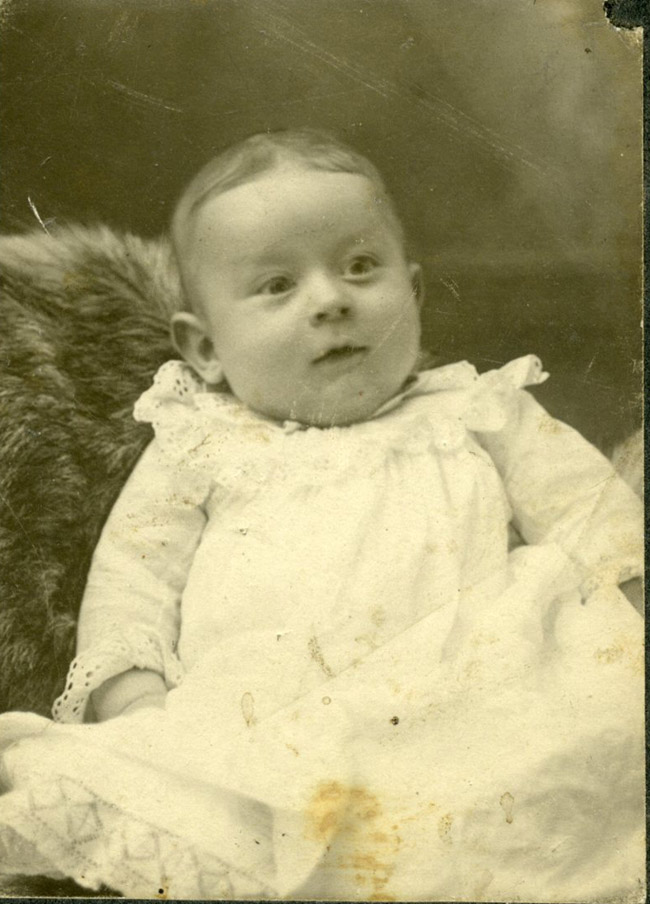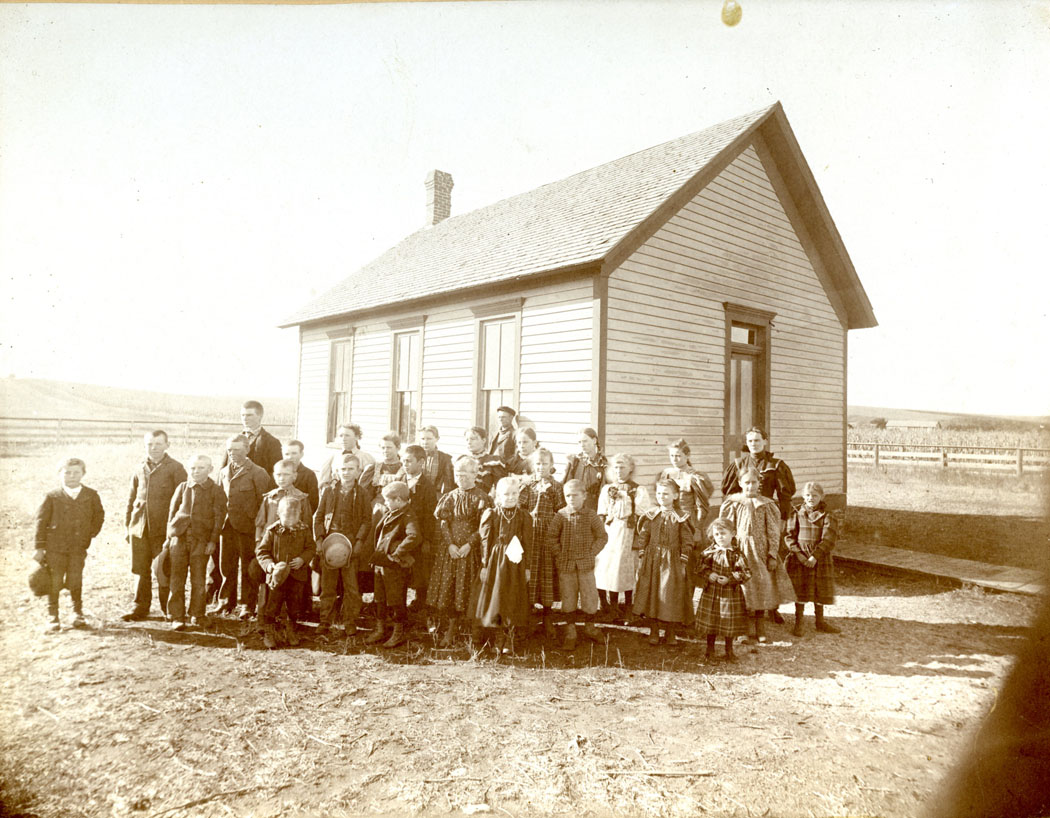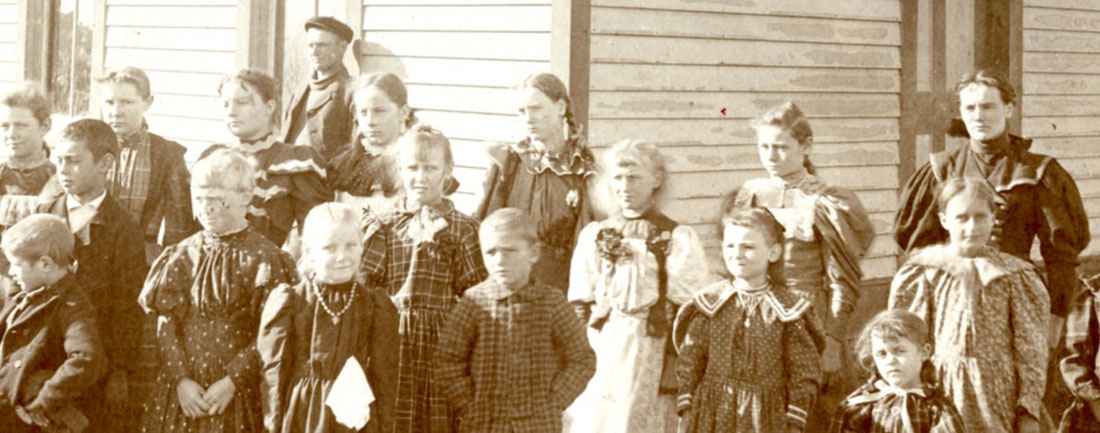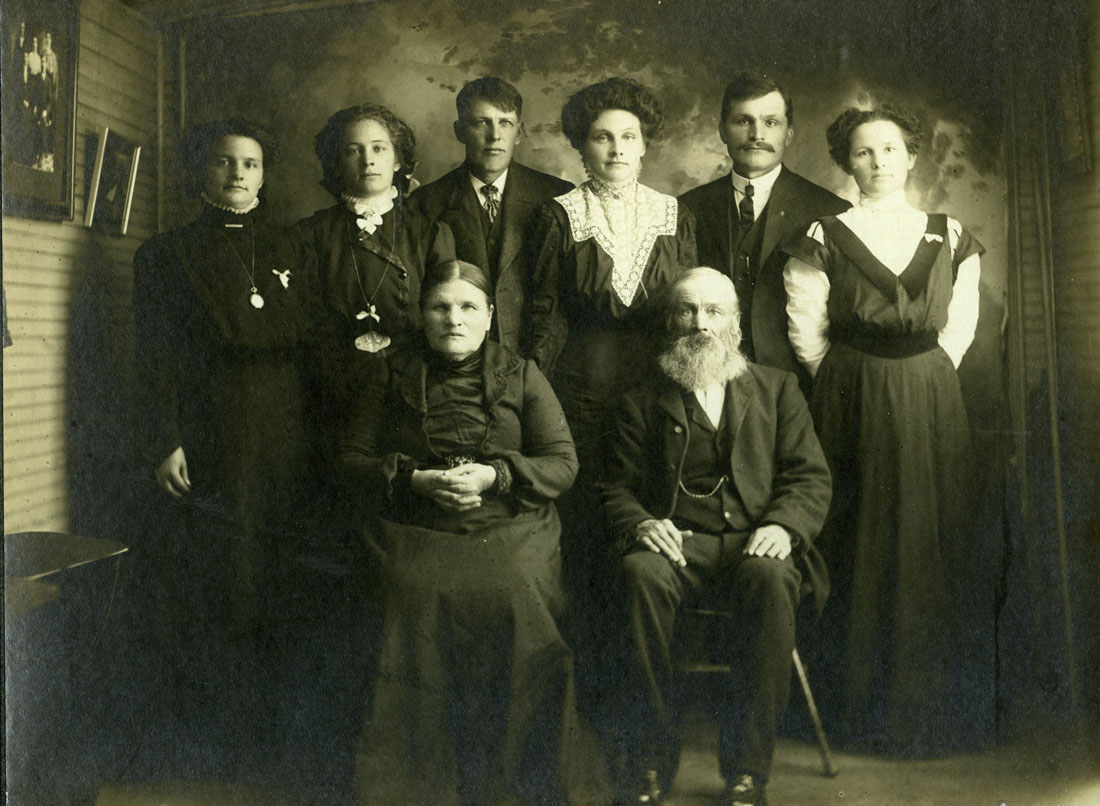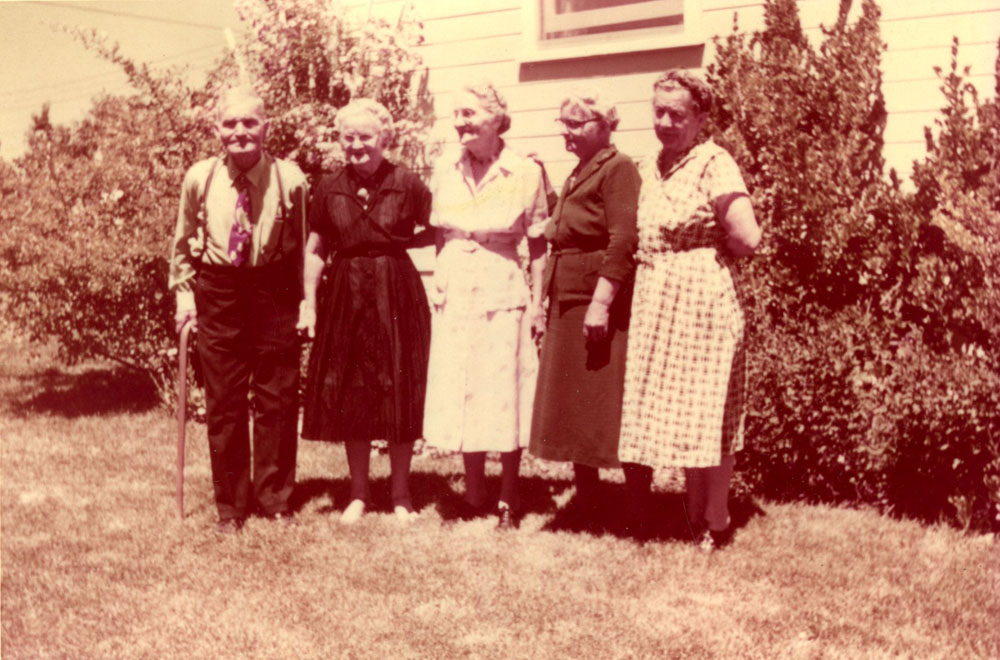Anna Ellen Ender Vogt
Barr
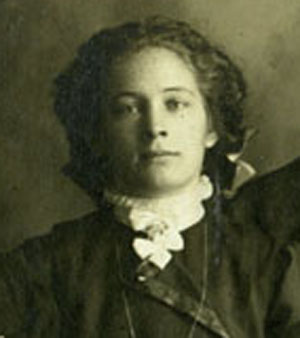  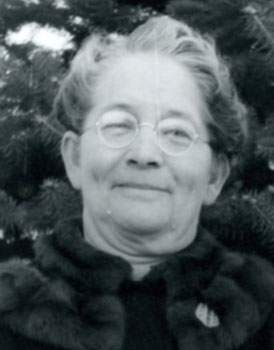
By Doug Boilesen (grandson of Anna),
2018 in honor of Betty Barr Boilesen, Anna's daughter.
Anna Ellen Ender Vogt Barr was born
on April 7, 1884 in Elba, Nebraska.
Her mother, born in Sweden, was Bertha
Johnson Ender. Her father, Christian Ender, was born in Switzerland.
Anna "Entered into Rest"
May 29, 1959 in Elba, Nebraska.
Elba School - Circa 1896
(Sarah "Tae" Ender and Anna Ender, third and fourth from
left in back row) Teacher on the far right is perhaps Anna's sister
Mary or Maggie.
Anna and Sister Sarah's
perfect attendance report as reported by their Teacher and sister
Maggie - April 9, 1897 School Report. - St. Paul Phonograph
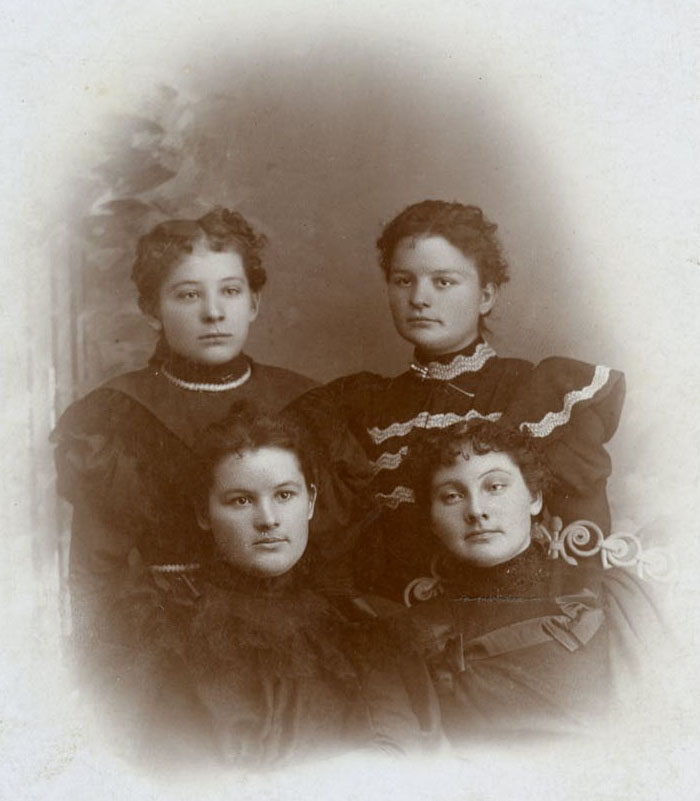
The Ender sisters ca.
1894 - Top left Anna, Sarah (Tae); Bottom row Mary and Margaret (Maggie)
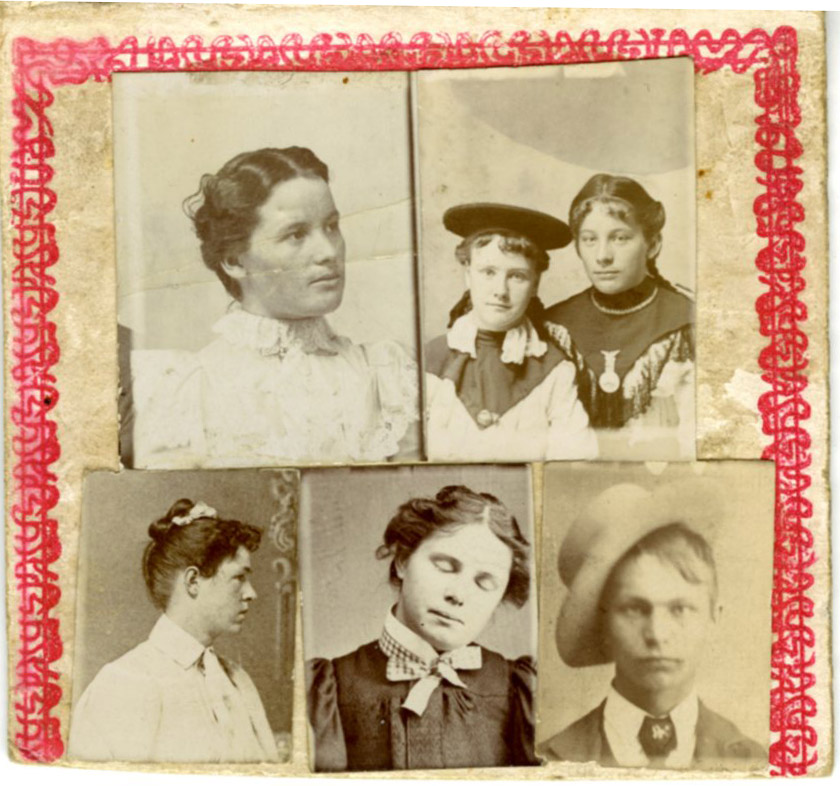
This 3" x 2.5"
cardboard card on the back in pencil is written "Belongs to Anna
Ender"
Photos unconfirmed but
believe Mary on top left, Anna in other photo on top and on the far
right perhaps with a friend to her left. Bottom row far right is perhaps
a brother.
The Ender Sisters circa 1900: Sarah
(Tae), Anna, Maggie and Mary with brothers. Parents Bertha and Christian
Ender are in front row.
Anna Ellen Ender married Frank A.
Vogt (b. 1883) on December 28, 1900 in Grand Island, Nebraska. (Note
marriage license says "Miss Ellen Anna Ender."

A "Cotesfield Item" for
February 28, 1902 in the St. Paul Phonograph Press noted
that "Frank Vogt of Fairdale has rented Mr. Chinn's farm formerly
occupied by Fred Jeffries and moved in Saturday."
A "Cotesfield Item" for
March 28, 1902 in the St. Paul Phonograph Press: "Mr.
and Mrs. Ernest Vogt who were married Wednesday of last week, have
moved in with his brother Frank Vogt."
April 18, 1902 "Mr. and Mrs.
Frank Vogt have been visiting at the parental home in Fairdale the
past two weeks." - St. Paul Phonograph Press
The August 28, 1903 St. Paul Phonograph
Press "Elba" report stated that "Frank Vogt was
building a new house."
May 13, 1904 St. Paul Phonograph
Press "Elba Neighborhood News": "Frank Vogt and
his wife and Fred Vogt and his family spent Sunday with E. Vogt.
"September 23, 1904 St. Paul
Phonograph Press - "Fred Vogt and family and Mrs. Frank
Vogt and children took in the Farmers' picnic.
"Ernest and Frank Vogt and wives
"attended the A. O. U. W. picnic in St. Paul Saturday."
- June 7, 1907 St. Paul Phonograph Press
Frank died February 23, 1914 leaving
two sons (Ray and Chris) and one daughter (Fay). The
Phonograph,
Obituary, February 26, 1914
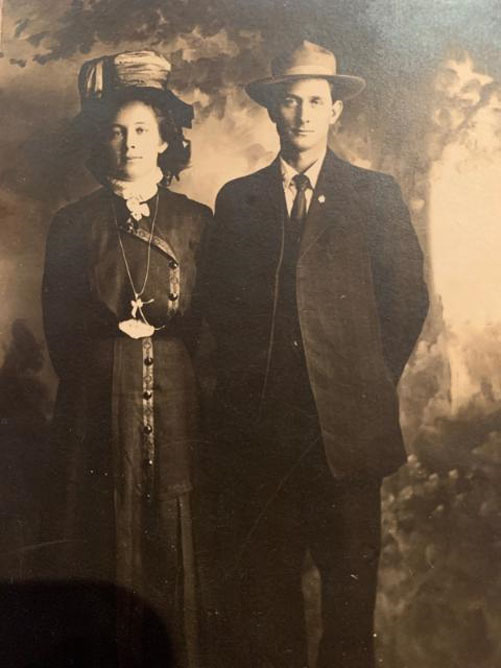
Anna and Frank Vogt
Anna's sister Sarah "Tae"
Ender married Ernest W. Vogt (brother of Frank) on March 19, 1902.
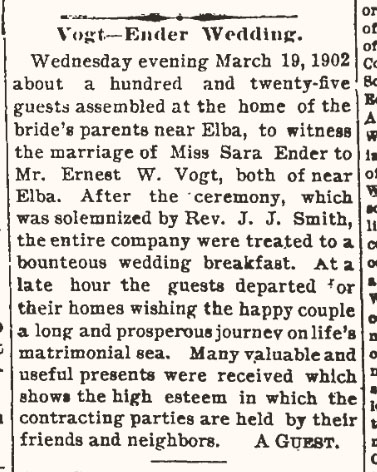
St. Paul Phonograph
and Press, March 28, 1902
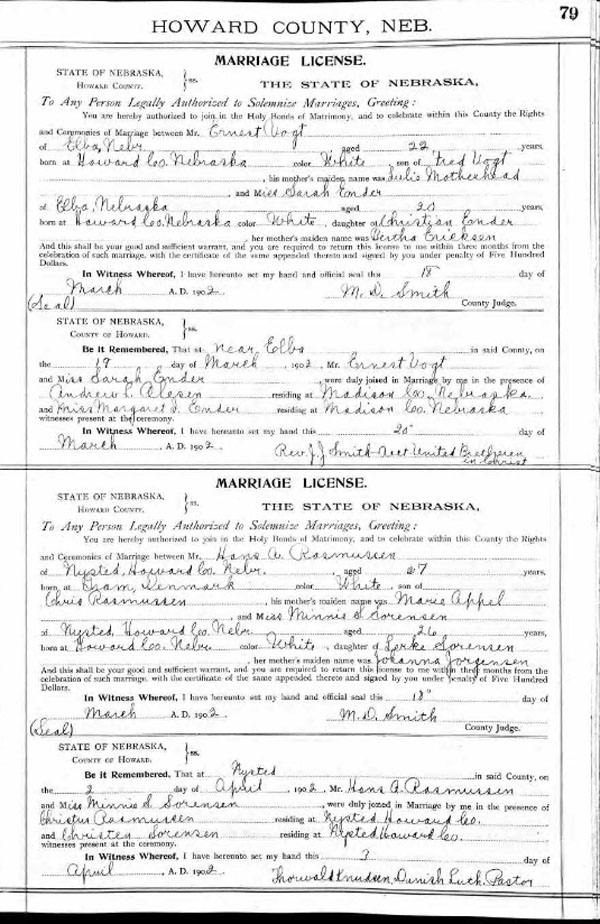
Anna and Frank had three
children: Ray (May 12, 1901), Fay (March 22, 1904) and Chris (November
4, 1907).
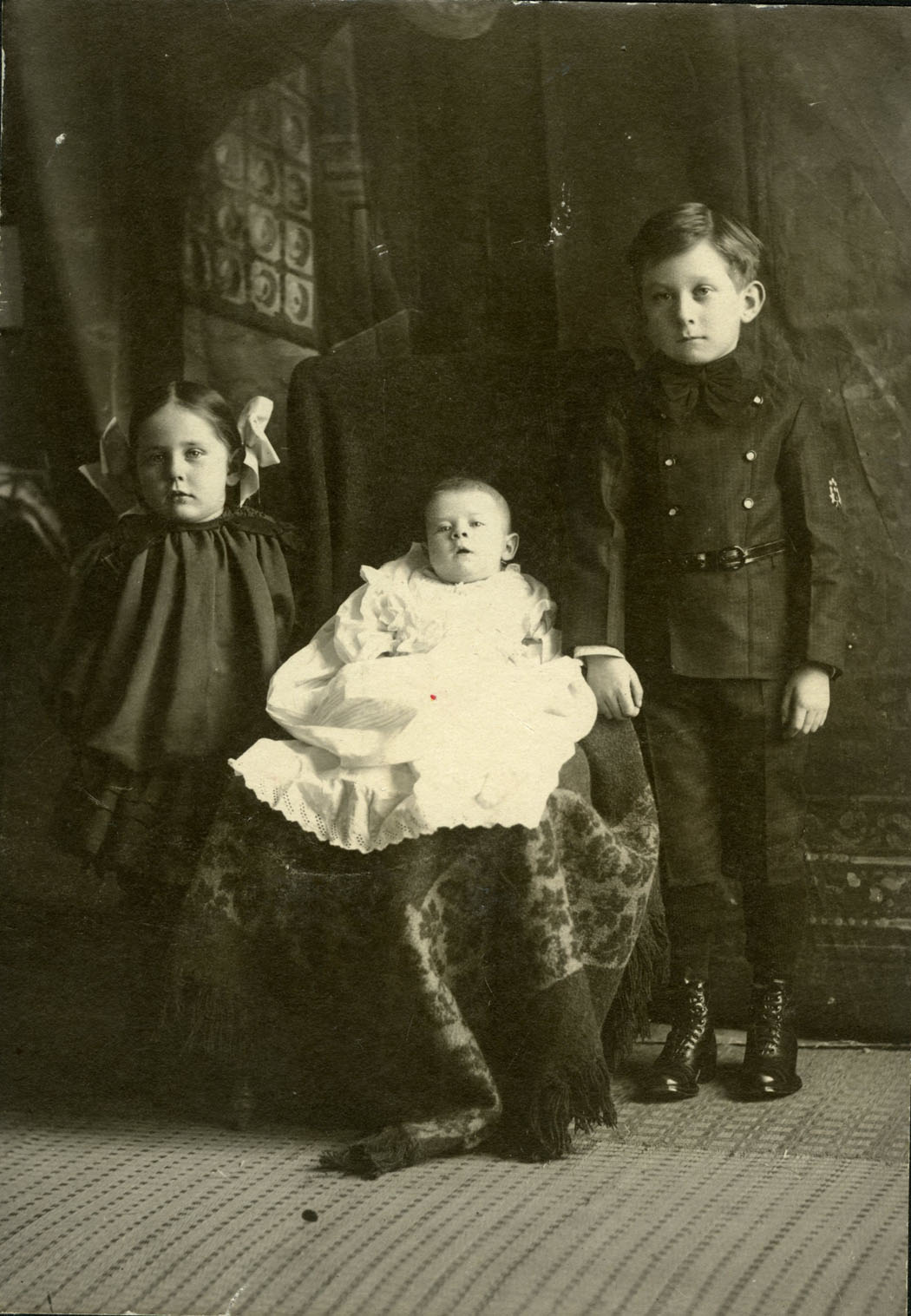
Fay, Chris and Ray Vogt,
circa 1908
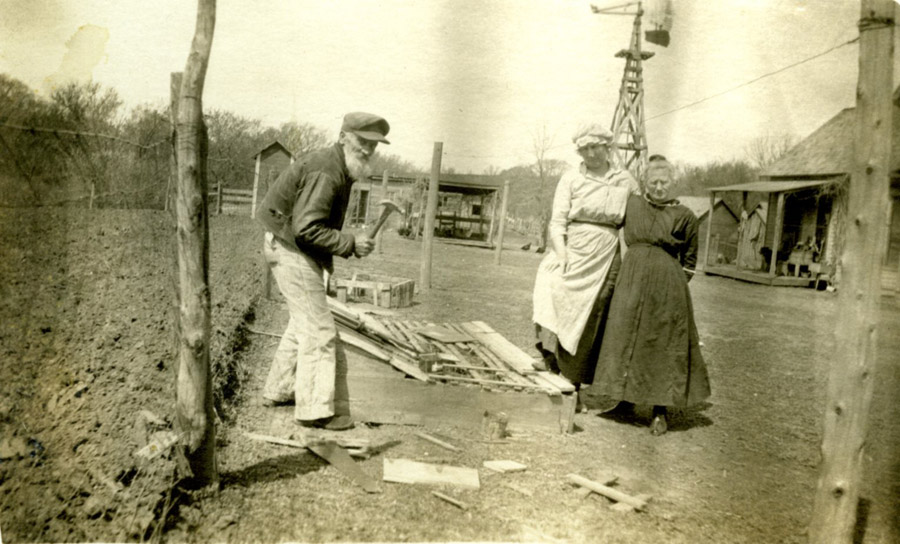
Circa 1910 RPPC unposted with note
on back "Anna V. now aint we cute" - unconfirmed but believed
to be Ender farm with Christian Ender holding the hammer, Anna standing
on left with white cap and unknown on right but perhaps sister Sarah
(see back porch and windmill
of Christian and Bertha photo with grandchildren used for identification
of this location.)

Anna was active in her
church all of her life. Howard County Herald, March 9, 1922
Anna Ender Vogt married Manley Miller
Barr on Monday, October 16, 1922 in Grand Island, Nebraska.
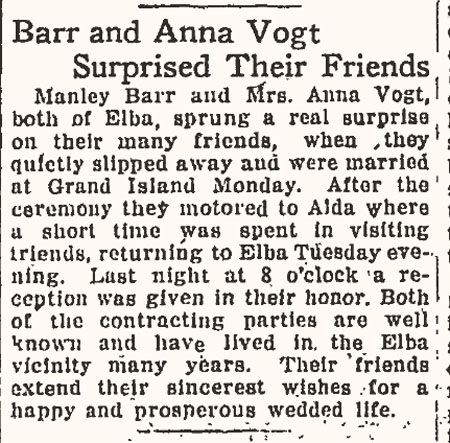
The Howard County
Herald, October 19, 1922 p.1
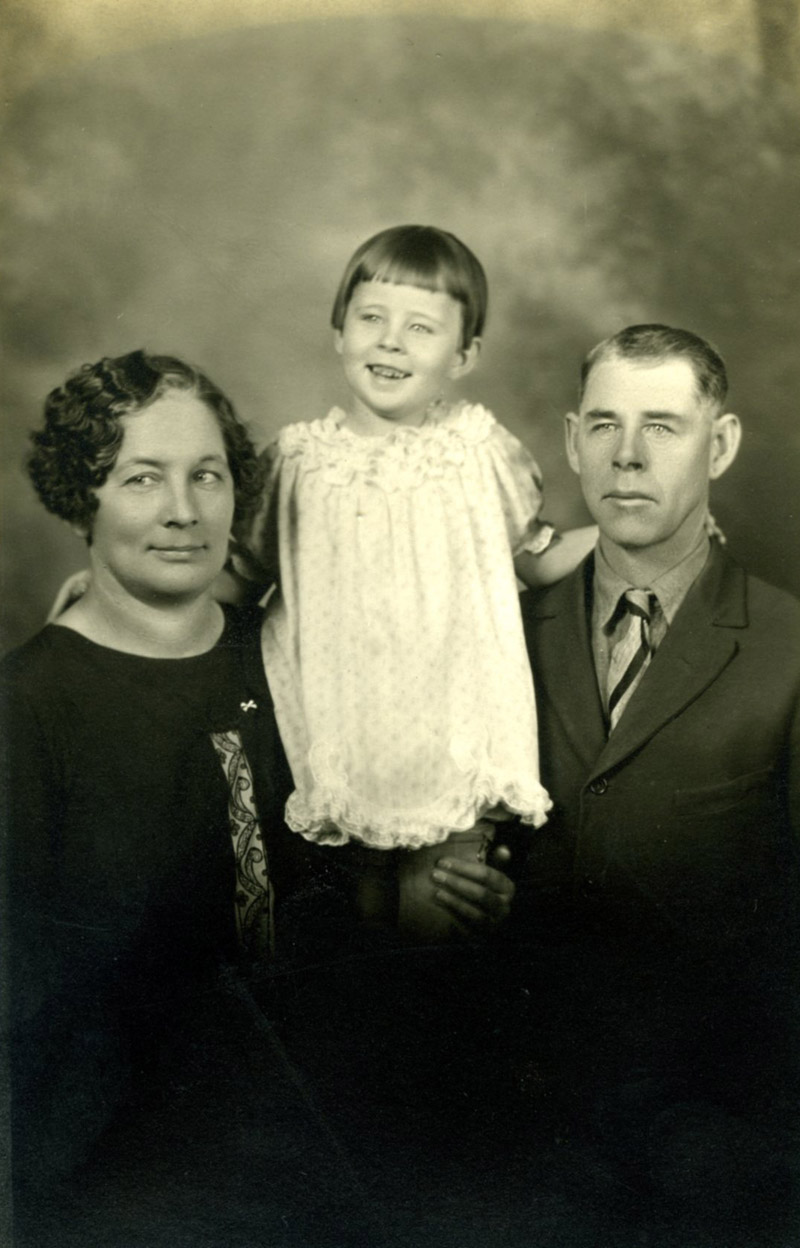
Anna and Manley had one
daughter, Betty Ann Barr.
KITCHEN AND DAIRY
- CAKES - HOWARD COUNTY FAIR

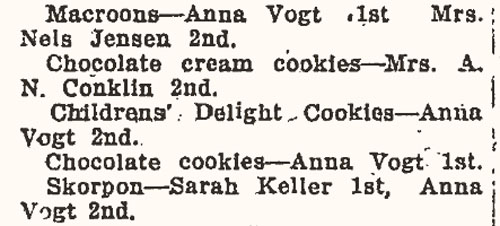
Howard County Herald,
October 12, 1922
Anna's older sister's marriage, Sarah
"Tae" to Frank Vogt's brother Ernest W. Vogt ended in
divorce according to The Howard County Herald October 1,1925
article on Ernest's death and his "addiction to the use of
intoxicating liquor" (Ernest Vogt b. Aug 1, 1879 to Sept 27,
1925) (1)
Anna was an active member of the Women's
Christian Temperance Union and as a young girl Betty remembers going
to some meetings with her mom, her aunt Sarah (Tae) Vogt and her
sister Faye (Mrs. Ericksen).
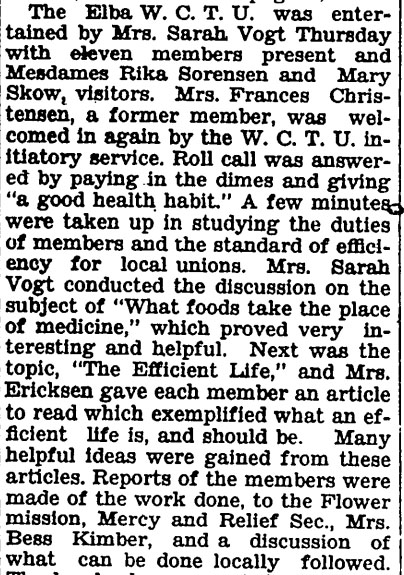
Elba News, The
Phonograph, St. Paul, January 11, 1928
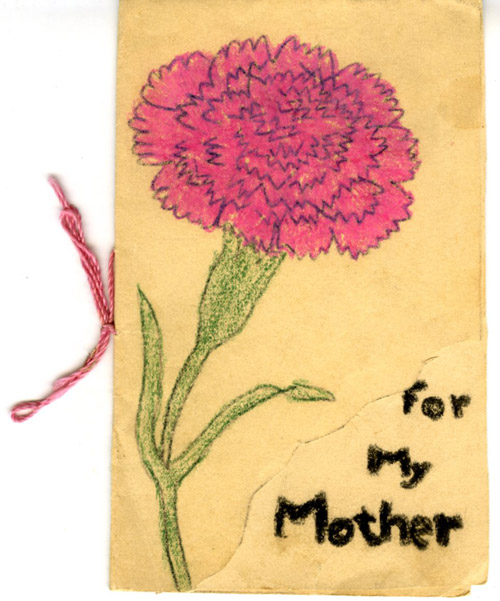
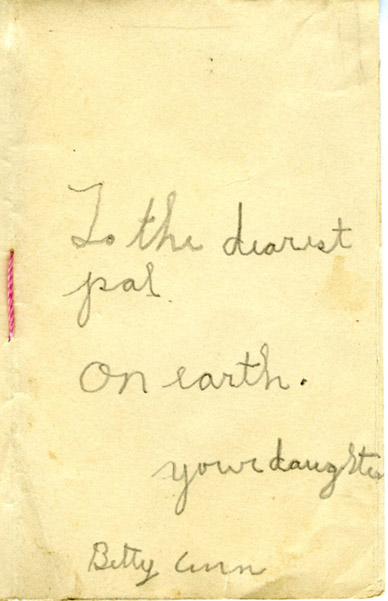
Card made for Anna by Betty Ann circa
1933
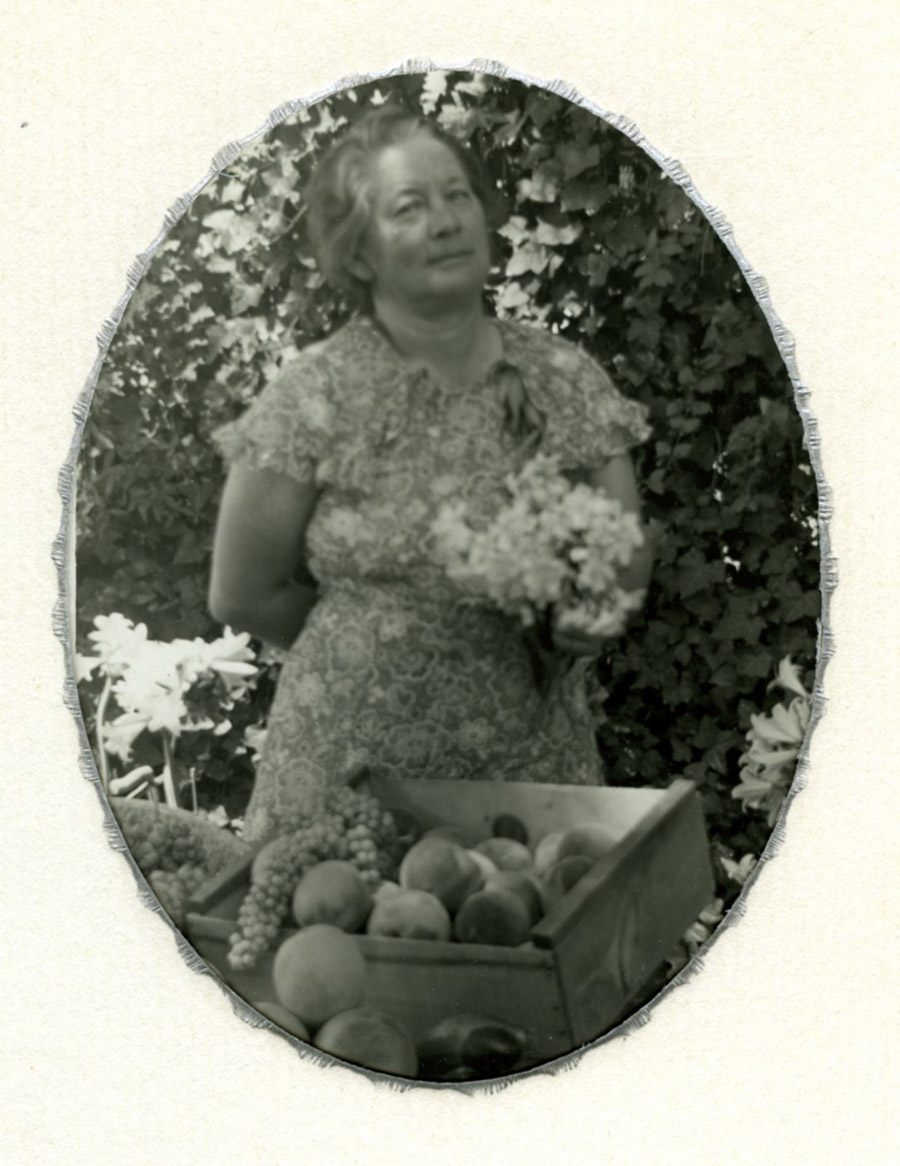
Anna on California trip,
1940
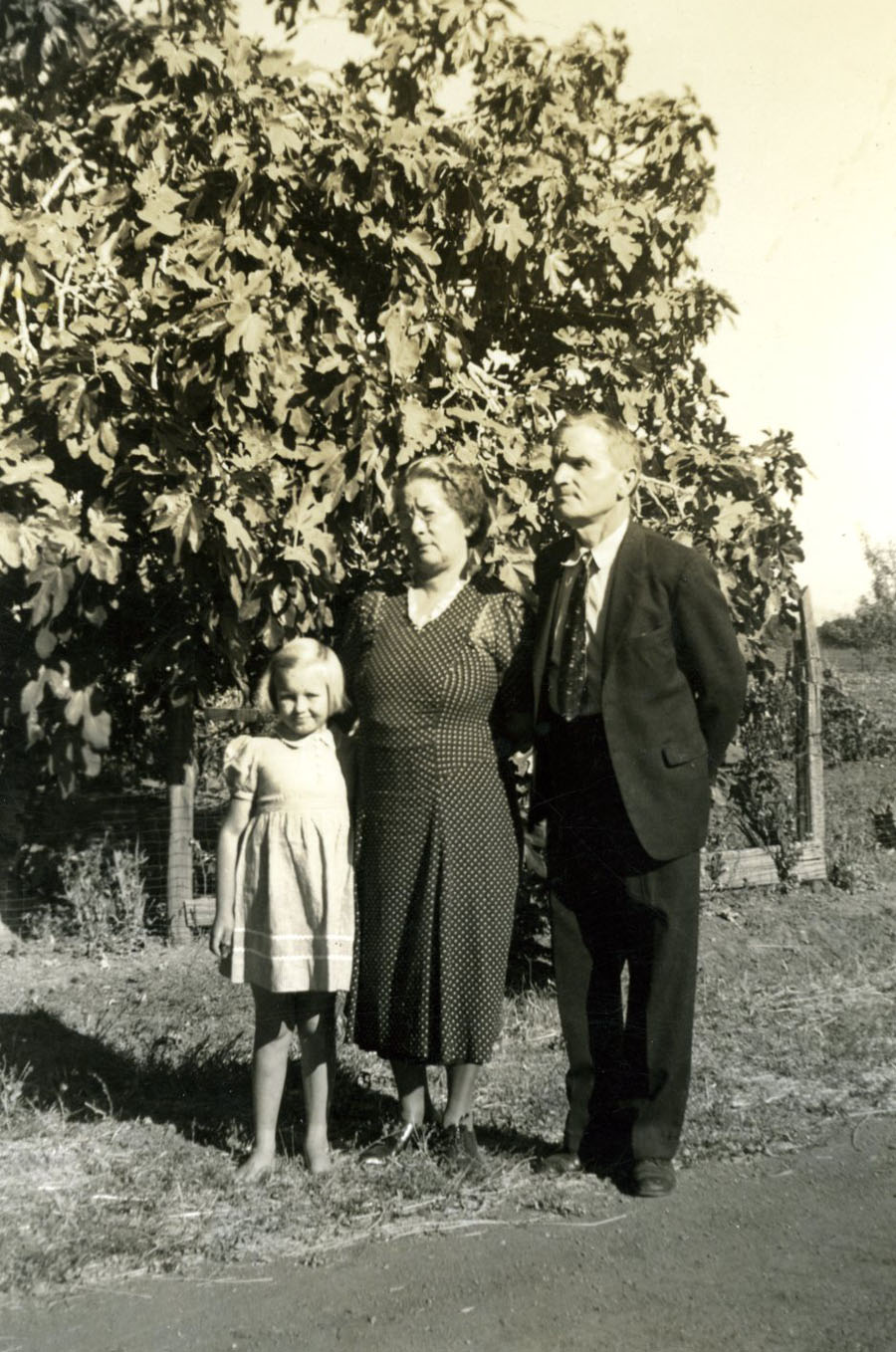
Anna with Brother W.
S. Ender and Marilyn Webb in Esparto, California 1940
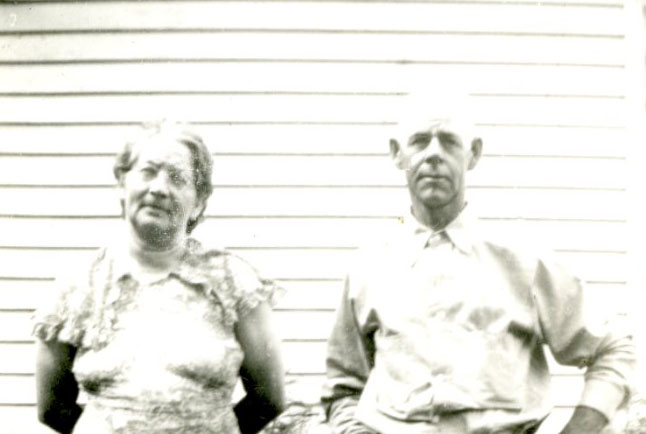
Anna and Manley, 1945
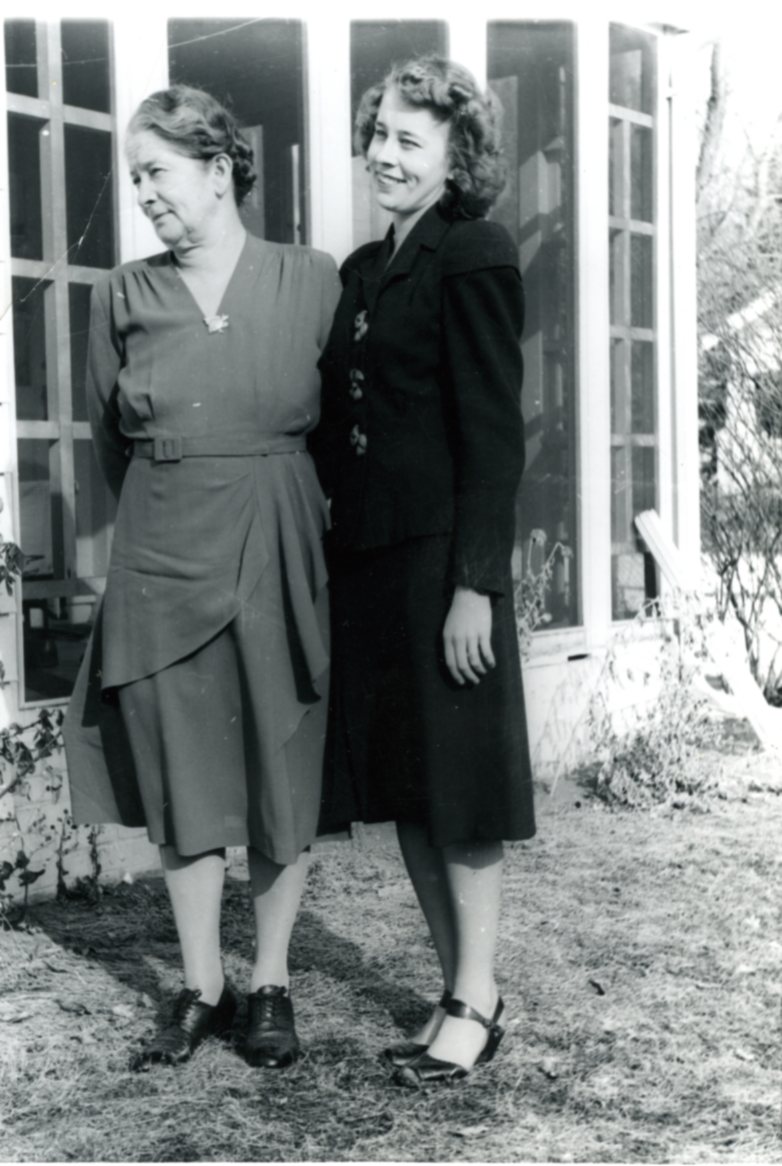
Mother and Daughter,
ca. 1943
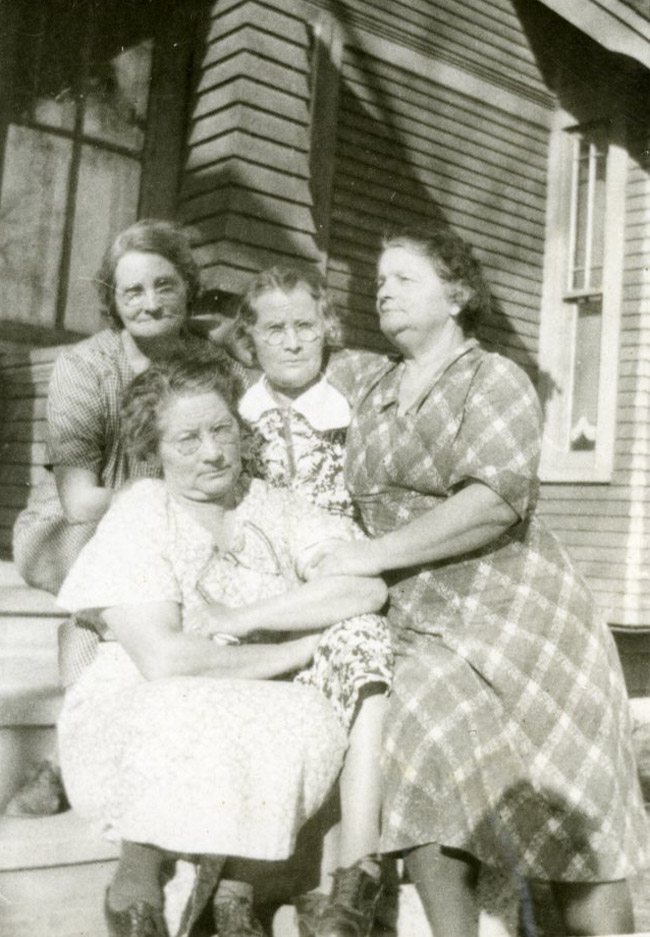
Anna (front left) with
sisters (Tay front right) Back row Maggie and Mary
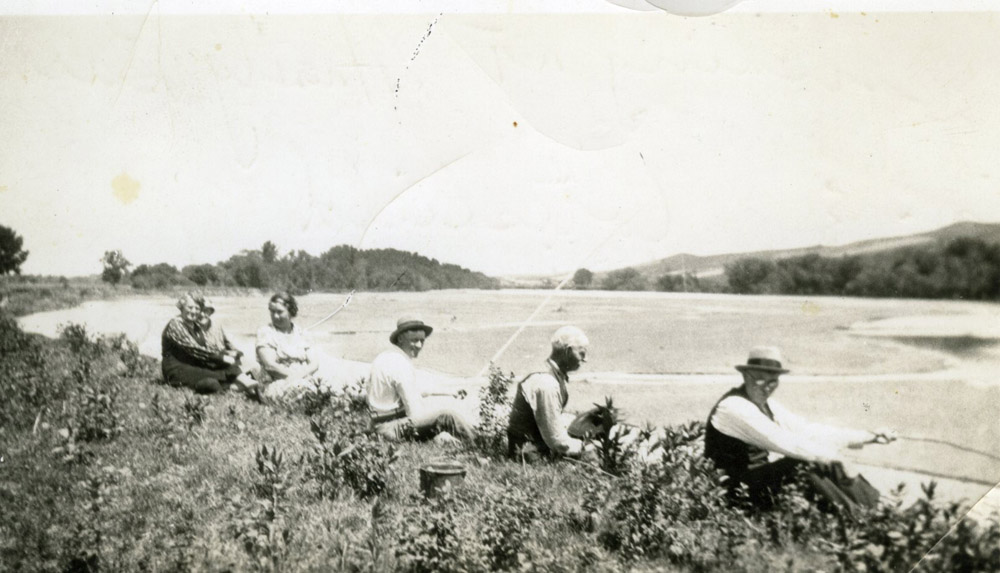
Fishing at Manley Barr's,
Cotesfield
(Back identified as Aunt
Mary, Ma McLaren, Mrs. M. Barr (Anna), Don, Uncle Jim, D.B. McLaren)
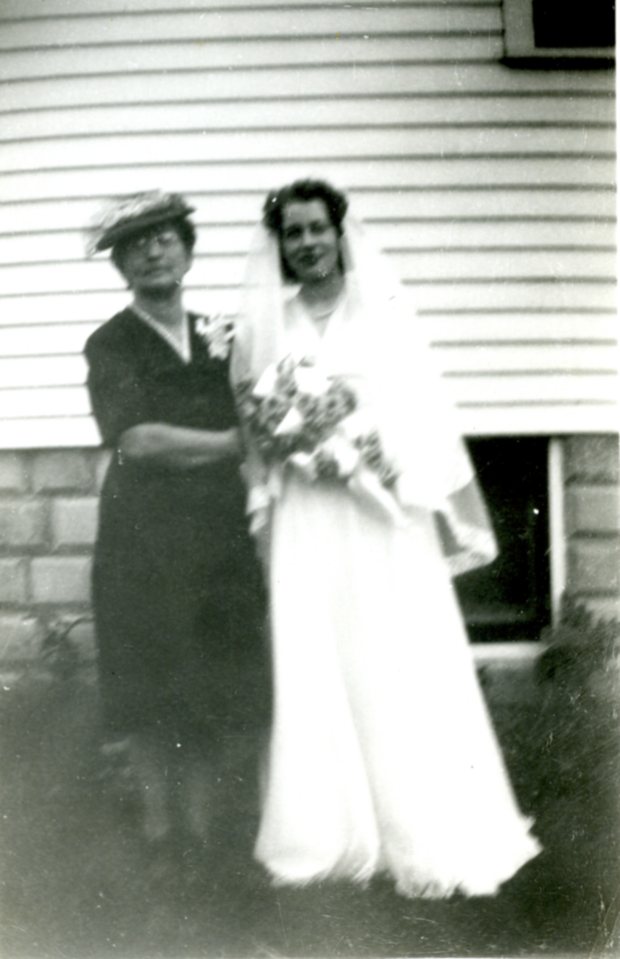
Mother and Daughter,
August 25, 1946

Celebration of 25th Silver
Anniversary, October 22, 1947
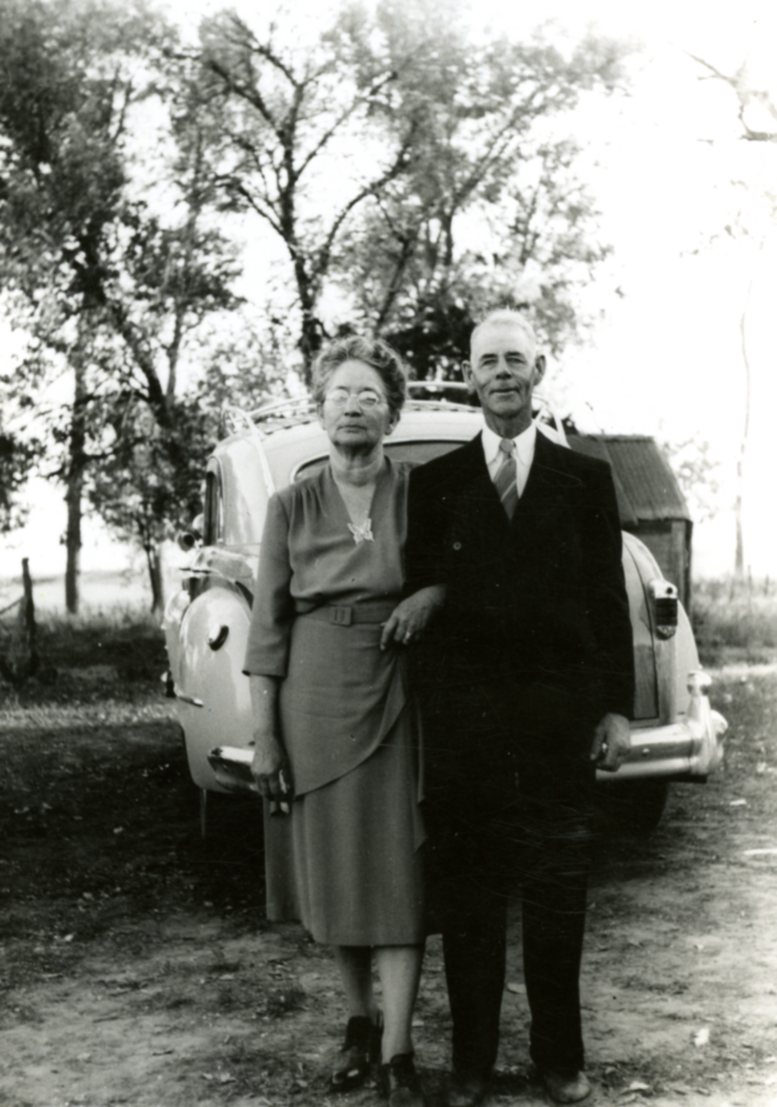
Anna and Manley, October
1947
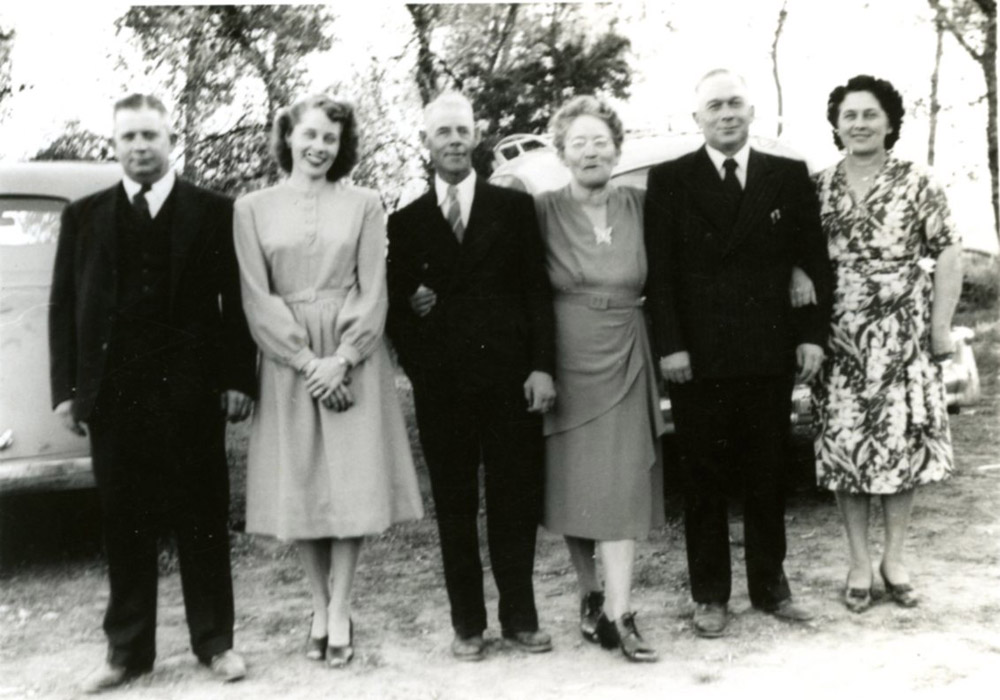
L-R Chris, Betty, Manley,
Anna, Ray, Fay - October 1947
"Ain't I horrid,
but can't help it, as its my own children." written on back of
picture asking for it to be sent back.
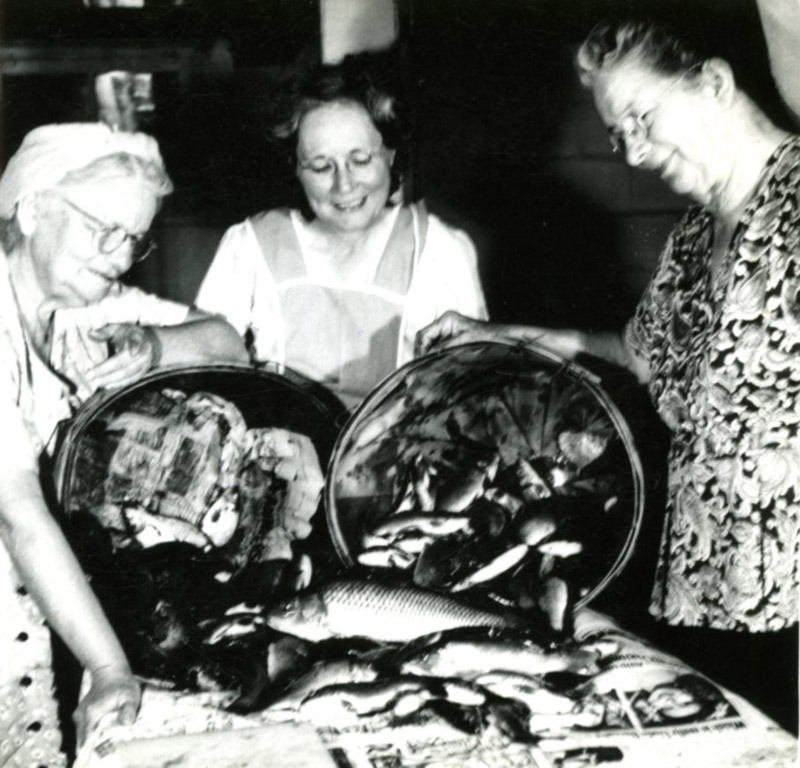
Anna loved to fish with
Sister Sarah 'Tae' on far left, circa 1950 and Edna in the middle.

COTESFIELD NEWS:
The Phonograph, September 23, 1953
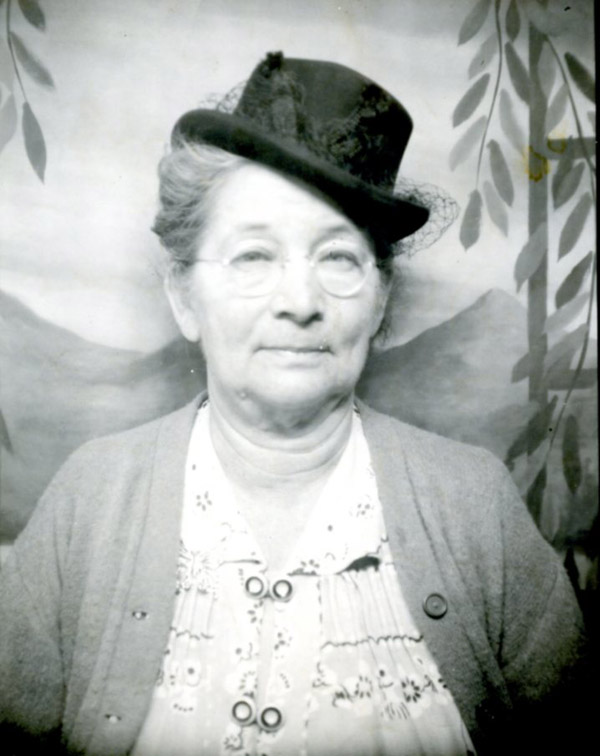
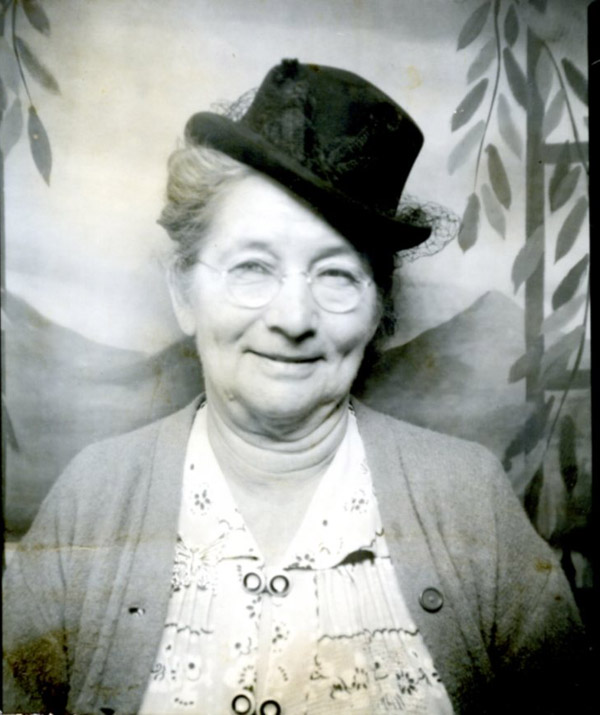
Request on the back on
the picture in pencil reads: "Send it back please. This or
these 2 are the ones Sara had a laughing fit over."

Mother and daughter,
ca. 1948
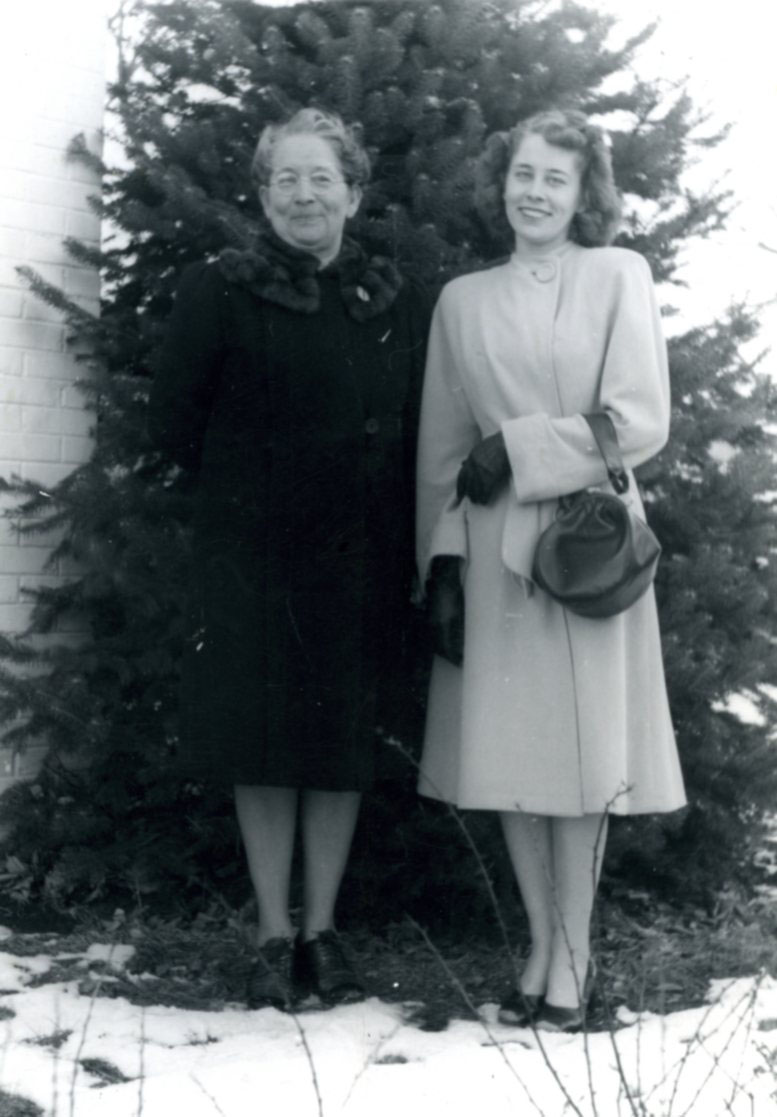
Mother and daughter ca.1948
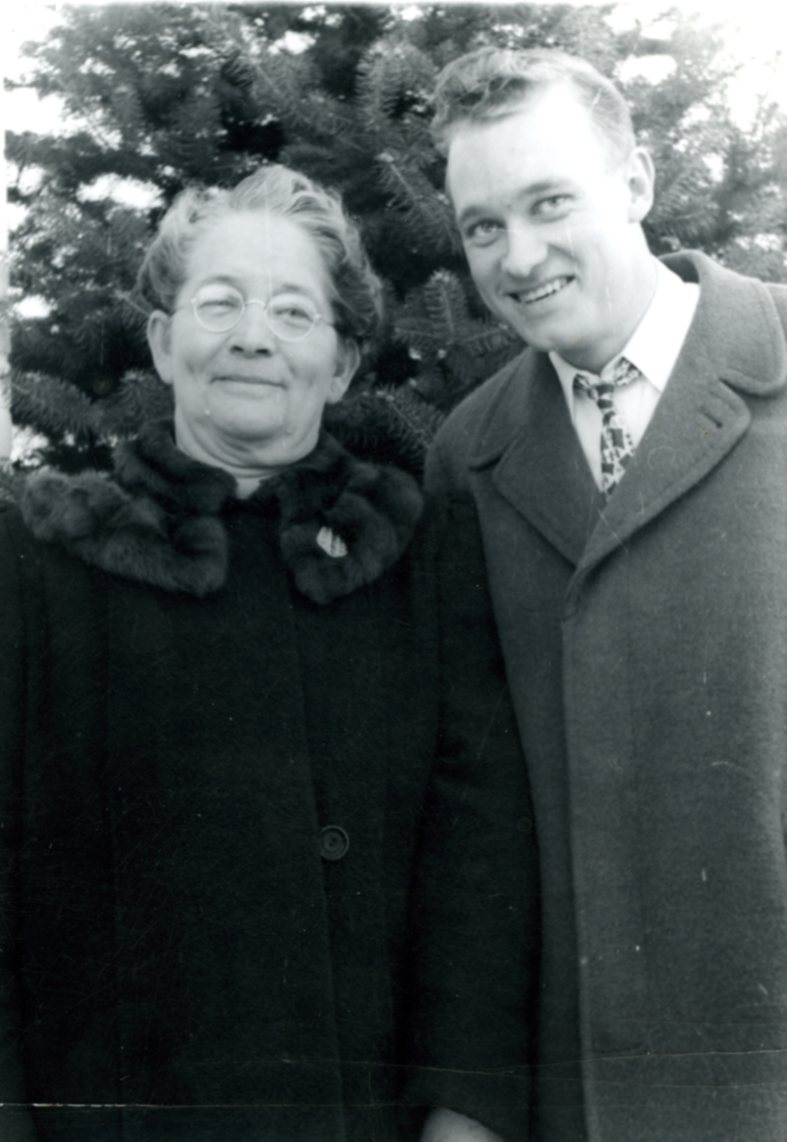
Anna and Axel
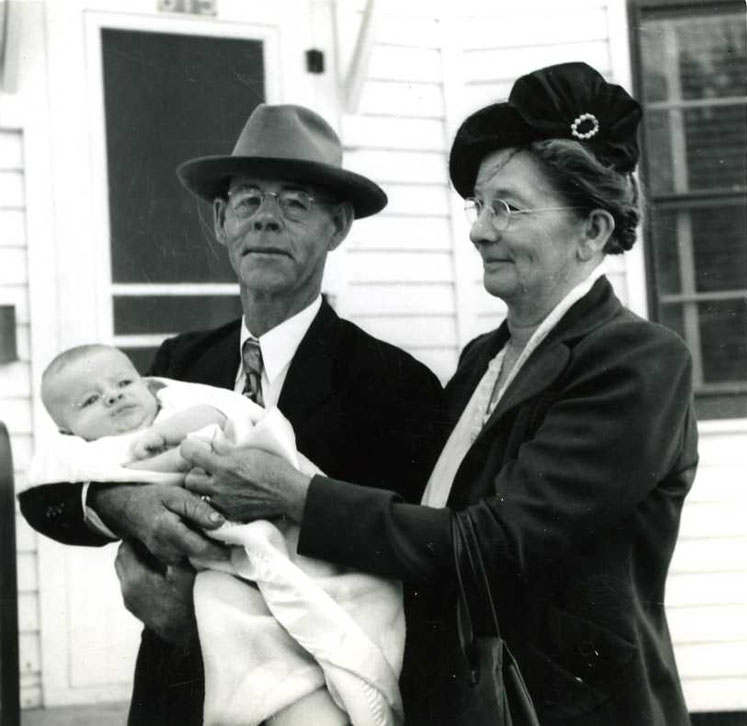
Manley and Anna with
"Dougie," September, 1950.
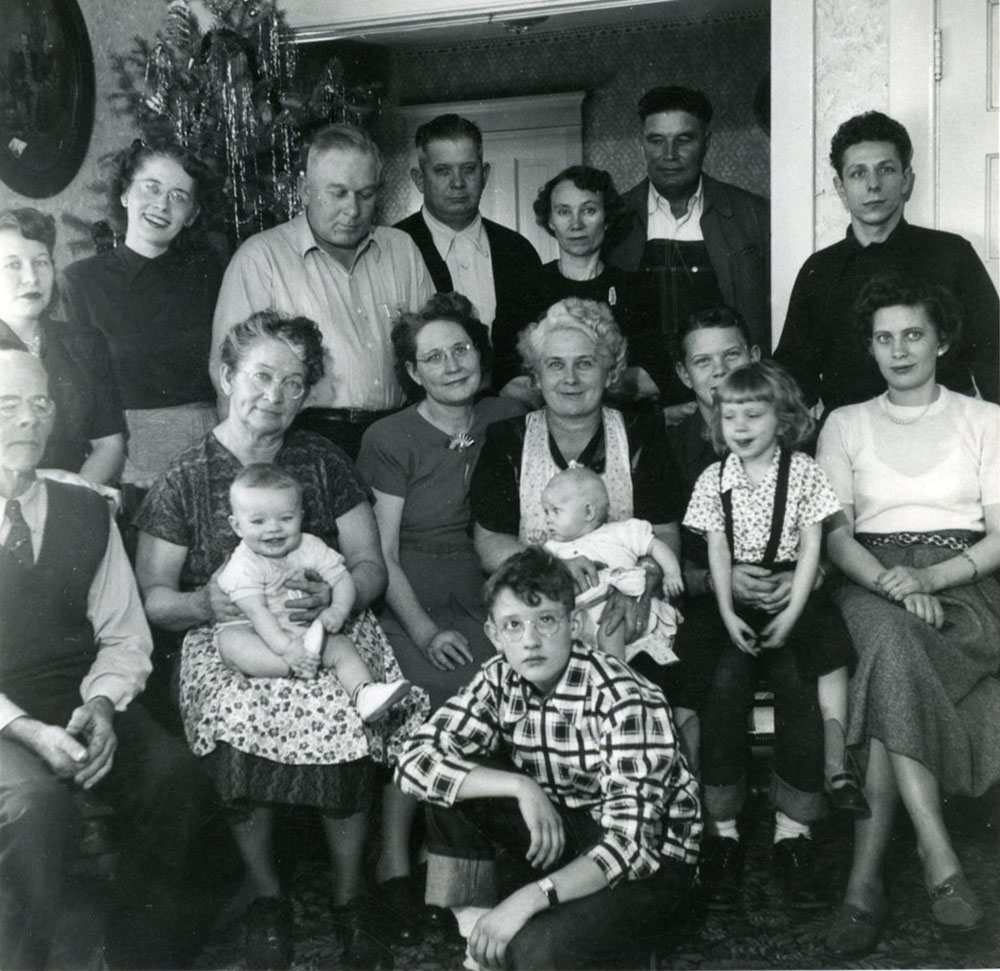
Christmas 1951 with Anna
Barr's children and grandchildren
Front L to R: Manley, Anna with Doug
on lap, Edna, Fay with baby on lap, Gary V. in front of Fay, Frank
V. with Linda Holechek on lap, Dorothy Holechek
Back L to R: Mary Ann? (Andus's niece),
Betty B., Ray V., Chris V., Hilda V., Andus E., Elmer Holechek
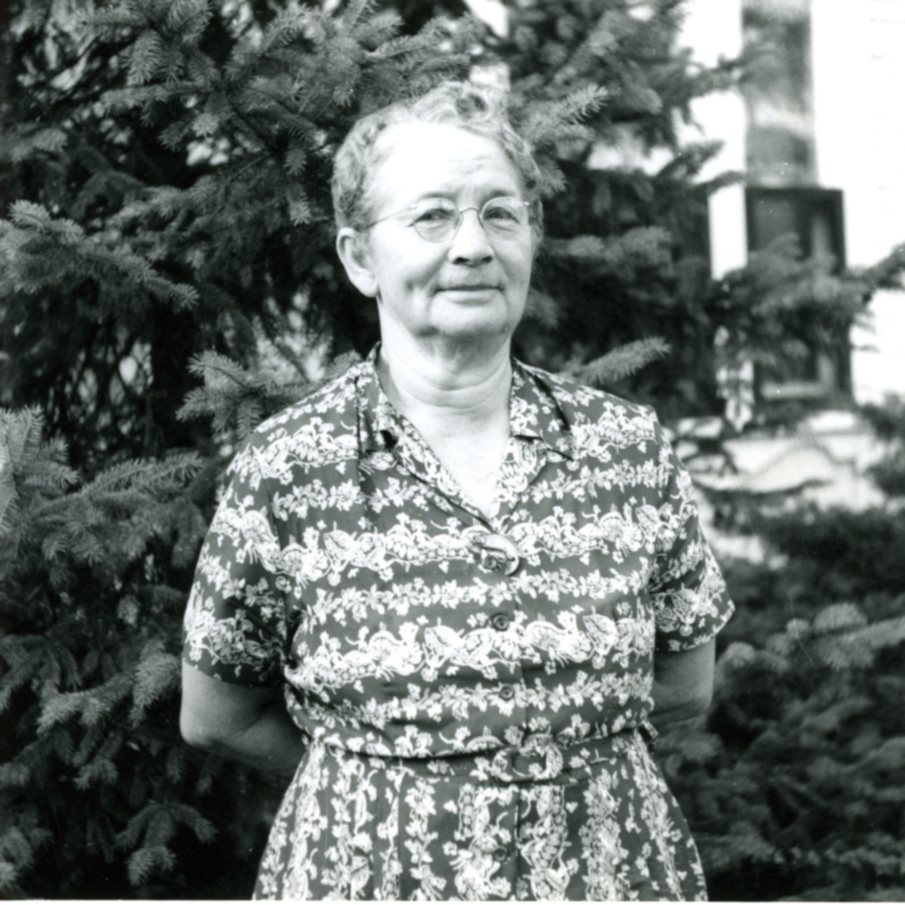
Anna ca. 1951
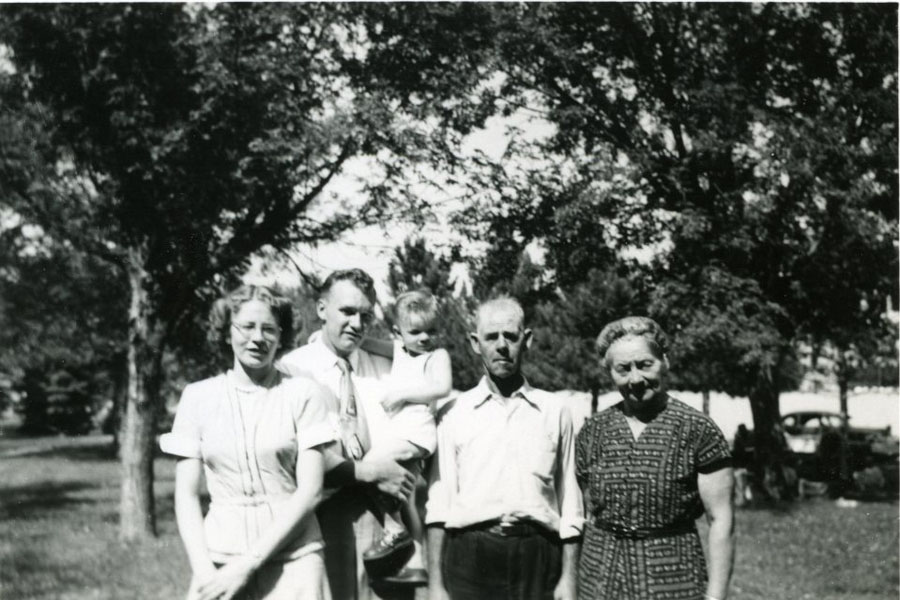
Betty, Axel, Doug, Manley
and Anna, ca. 1952

This Meditation
was sent by Betty to her mother sometime in the 1950's. Anna wrote
that she loved it. After Anna passed according to Sister Bev our mother
had it taped to the inside of her kitchen cabinet.
June 1955 at Fair Oaks,
California at Mary Lindsay's home - Bertha and Christian Ender children:
W.S. Ender, Margaret 'Margie' Olson, Mary Lindsay, Sarah Vogt and
Anna Barr.


ELBA NEWS: The
Phonograph, June 15, 1955
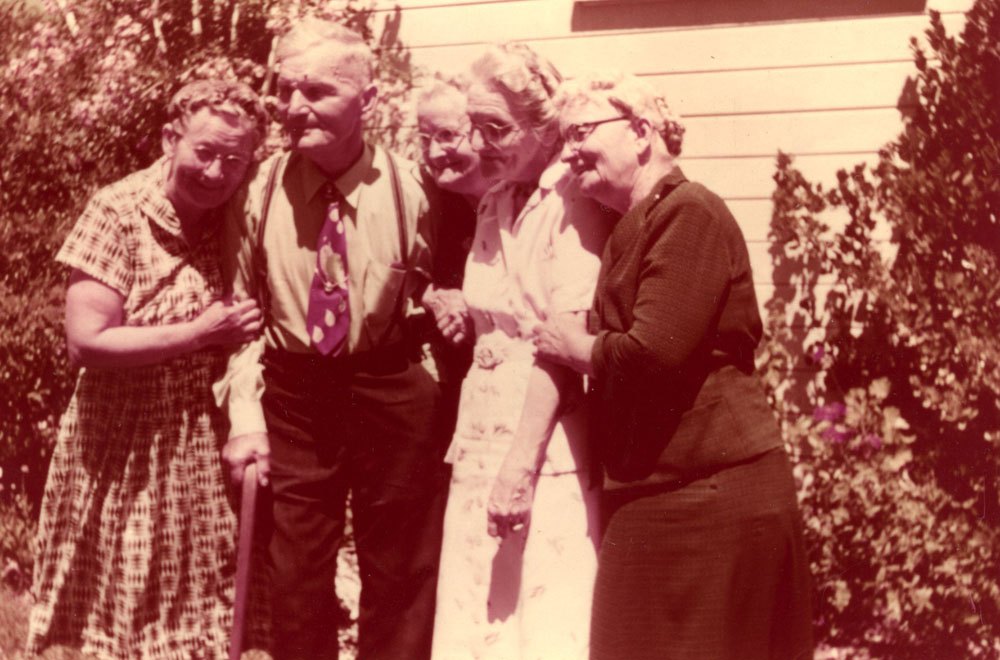
Anna Barr, Willie Ender,
Margaret 'Margie' Olson, Mary Lindsay, Sarah Vogt
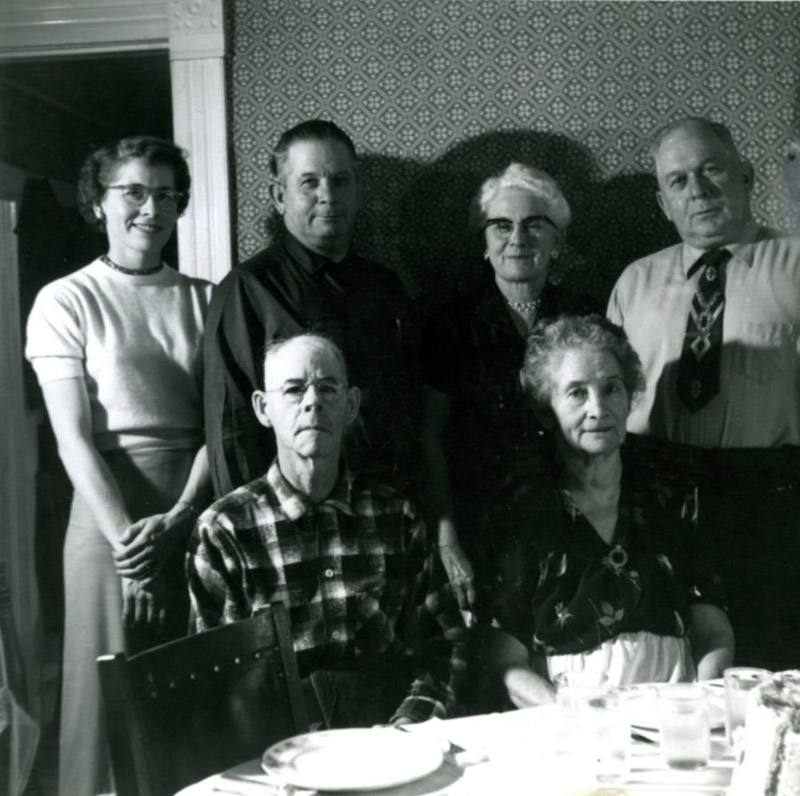
April 1956 - Anna's writing
on the back: "My Dear family send this back. its all I have yet
that you may care to see how we look."
L-R Back: Betty, Chris,
Fay, Ray
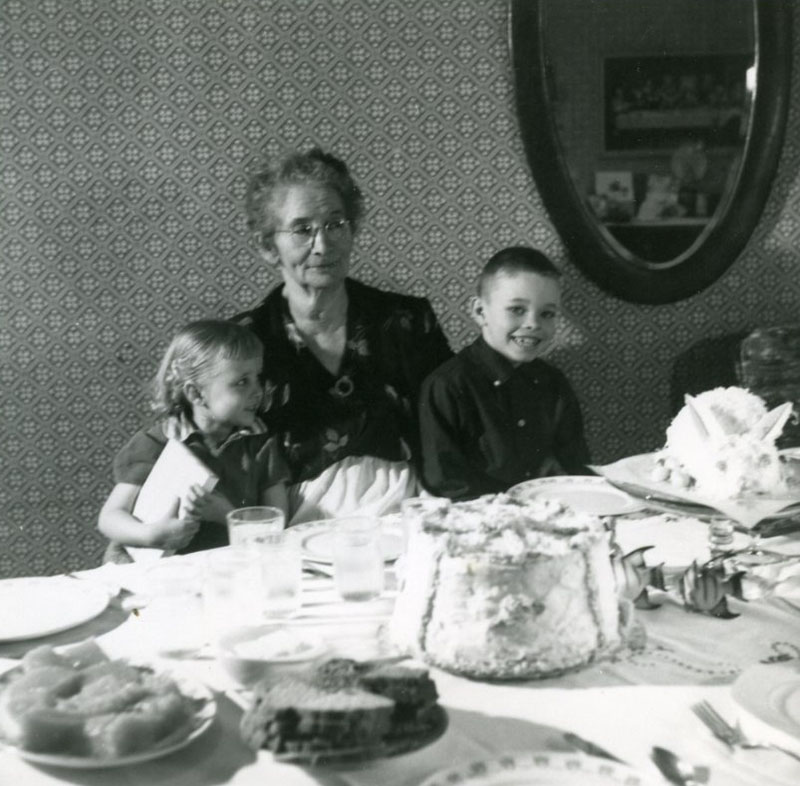
Bev, Grandma Barr and
Doug at her house in Elba for an Easter dinner, April 1958
Doug Boilesen "My Grandmother,
Anna Barr" - Popular Culture and other memories
I don't have many memories of my grandma
Barr's farmhouse as I was not yet five when they moved to town (Elba)
after selling their farm which was near Cotesfield.
Their Elba house, however, I do remember.
It was a square, two bedroom single story white house on a large
lot (about an acre) with only one other house on their "block."
They had a garden with potatoes, green beans, peas, and sweet corn,
two red mulberry trees that I can remember being harvested by placing
a bedsheet under each and shaking its branches so that the berries
dropped (staining the sheet). There were several wooden sheds in
the back of the property for farming implements, tools and a chicken
coop. A stump used as a chopping block was also out there to be
used if chicken was to be on the dinner menu. A large oil drum was
used for disposing of anything that needed to be burned, probably
weekly. I always hoped we'd be there when that burning took place.
There was a large pile of corn cobs
probably 30 feet from the front door that was fuel for the cast
iron cookstove in the kitchen.
The cinnamon rolls, cookies and bread
from that oven remain the smells that I delightfully remember about
that house since my grandmother seemed to always be baking just
prior to our arrival. My grandmother's bread, preserves and butter
also made me a toast eater for life. But to make toast I had to
be supervised since each side of their electric toaster needed to
be pulled down to turn the bread over and toast the other side,
a process that exposed the electric coils. If the toast got burnt
my grandmother told me to eat it because it would be good for my
vocal cords and make me a better singer.
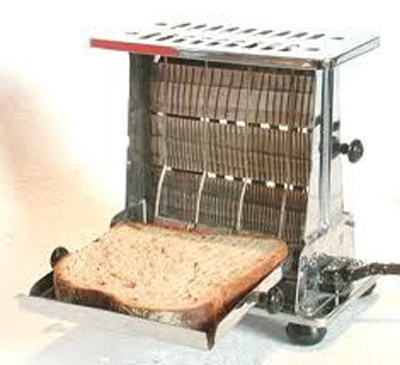
There were many Mason jars in the
pantry filled with pears and peaches that would be served with breakfast
or as a dessert. We ate at their oak table that also had more leaves
that could be added with fold-out legs which supported the extended
leaves if there was to be more than six people.
A large oval framed photograph of
my grandmother's parents was on one wall in the parlor and on the
other wall was a large print of Leonardo da Vinci's "The Last
Supper." Under that print was their oak buffet where some pictures,
cards and decorative pieces would be displayed. A nine-inch ceramic
fish was a nick-nack ornament on the buffet or on the bedroom dresser.
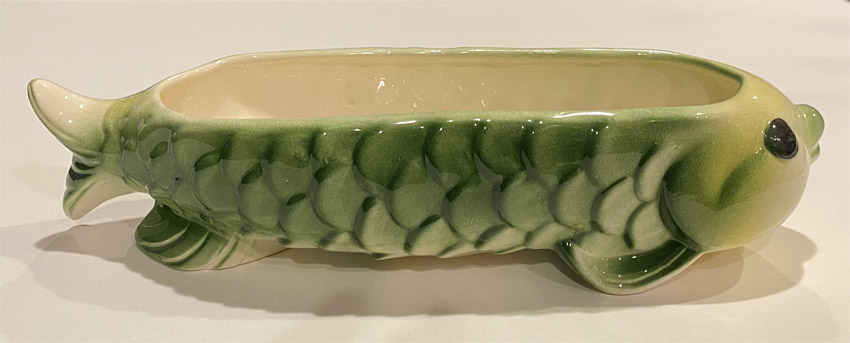
They had running water in the kitchen
but no indoor plumbing for the bathroom so the outhouse was always
an adventure that I didn't like. A wall telephone was in the parlor
but I don't remember the longs and shorts of their number. A table
radio was in the kitchen and they got a TV around 1956. There was
no phonograph in their house but my grandmother did buy the local
church's pump organ for $8 when the church decided to switch to
a piano for its services. I was taking piano lessons and my grandmother
wanted to have this organ in their house so that I could play for
her when we visited. They had a piano when Mom was growing up but
didn't have it when they moved to Elba.
Dad installed their new linoleum for
their kitchen by jacking up the iron cookstove and then rolling
the linoleum under the stove. When they did get their TV I know
my grandmother enjoyed "The Lawrence Welk Show," "The
George Gobel Show," "The Bob Cummings Show" (aka
"Love that Bob"), "I've Got a Secret," and "Art
Linkletter's House Party." My grandfather liked the boxing
shows and "Gillette Cavalcade of Sports."
My grandmother was a
life-long reader of the Bible and don't know much about other books
she read. However, one of her books I know she considered a favorite
was "Art Linkletter's Kid's Say the Darnest Things."
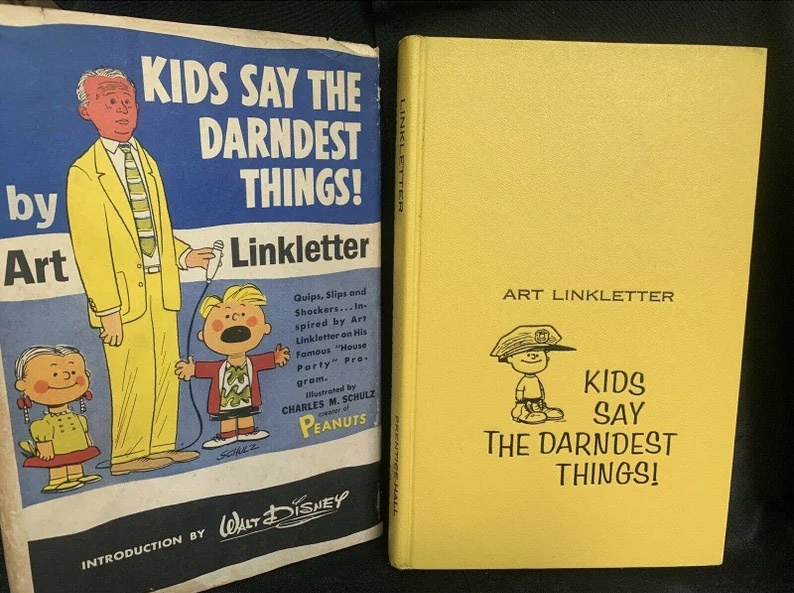
In the 1950's they had subscriptions
to the Sunday Omaha World Herald newspaper, the Nebraska
Farmer, The National Geographic, and the St. Paul Phonograph
newspaper. I probably saw my first Old Farmer's Almanac at
their house.
On their front door they had a "If
I'm not home leave a message box" with a pencil and paper inside
it. I never saw any messges in that box but remember at one point
National Geographics maps had been cut into message size
notepaper for the box. I must have made some comment about that
since she started saving those maps for me.

Almost exactly like the one in my
dad's parents house there was a china cabinet/desk in their parlor
and some Big Little Books from the 1930's and 1940's such
as Tarzan and Little Orphan Annie. In the 1950's I
know they subscribed to the Sunday Omaha World Herald newspaper
and that for many years they had a subscription to the St. Paul
Phonograph newspaper. My Sunday Comics reading had been limited
to the Lincoln Journal so it was at my Grandpa and Grandma
Barr's where I was introduced to Gasoline Alley, Li'l
Abner, and Joe Palooka which I read while sitting in
their mission style platform rocker.
I slept on their green sofa couch
with flannel sheets when we visited them in the winter. My grandmother
embroidered and I remember pillow cases with a colorful flower or
other design on it.
They never had a large Christmas tree
but the ones I remember had tinsel and a few bubble lights, candy
canes and some glass ornaments. My grandmother always put out her
clear plastic gum drop tree which she decorated with gum drops and
then left a few at its base like Christmas presents. I've always
had a sweet tooth and loved those gum drops. Grandmother's brother
Willy in California would send almonds and oranges to for Christmas
and I know that during the time my mother was growing up it was
a special event to receive their annual box of fruit and nuts from
California and Uncle Willy.

My mom liked to tell stories that
she heard or experienced while growing up and some of those are
in her Other Stories Growing Up section.
One story that isn't told is about what my grandparents called the
"Blizzard of '88." Although both of my grandparents were
not yet four or in school, the impact of the "Schoolhouse
Blizzard of 1888 in Nebraska was something talked about for
many years and recalled by my grandparents. It was embedded in popular
culture as an event that was completely unexpected but deadly.
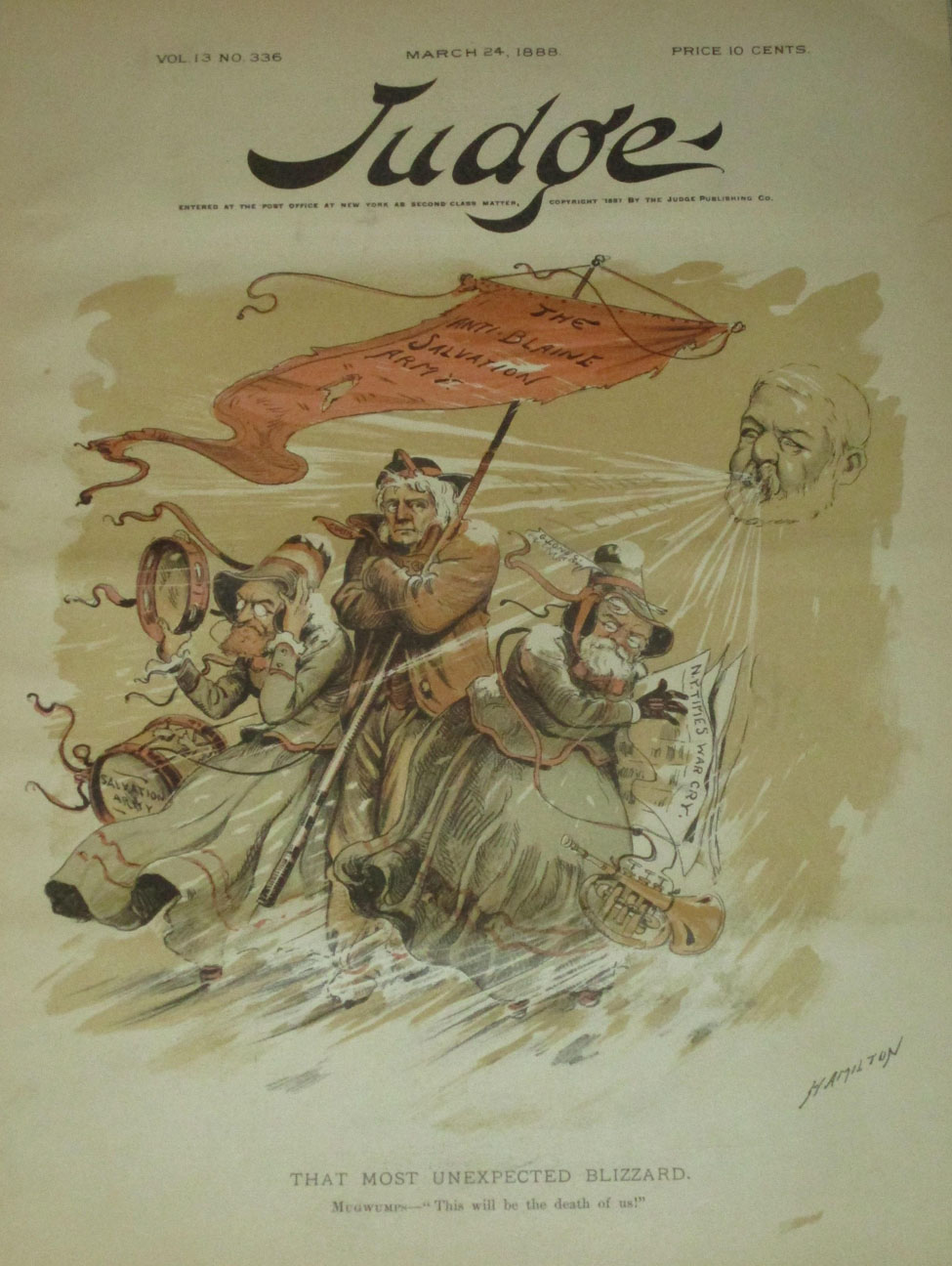
Judge Magazine,
March 24, 1888
The weather had a daily impact on
farmers with success or failure dependent on rain and always with
the risk of violent storms of wind or hail that could destroy the
crops; they needed a growing season without grasshoppers, crop disease
or fires. Banks, big business and the economy could change everything
(and too often not for the better for farmers) so annually crops
needed to be harvested without incident and then sold for a fair
price.
My grandmother experienced many changes
through the decades even though she lived her entire life in Howard
County, Nebraska. The introduction of the telephone, automobiles,
phonographs and recorded sound, movies, radio, television and print
media like magazines altered what she saw, heard and could do.
Consumerism changed what and how goods
were produced and sold. She went from churning her own butter to
buying it at the local store. The Rural Electrication Act brought
electric lights and power to her homes. She went from an icebox
to a Frigidaire; from beating the rugs to vacuuming; from a scrub
board and large, metal laundry 'pan' to an electric washing machine
(although always a clothes line for drying); from Mason jars of
fruit to canned foods from the market but I'll always remember the
peaches and pears she would continue to 'can.' And the preserves
and jams she made were always great on my toast. I can still picture
the rows of those Mason jars and smile when I remember that most
young Americans have no idea about home canning and preserving anything.
It also reminds me of a World War I poster that I saw when doing
some research about Uncle Sam that shows "preserving"
as being a patriotic act.

An article in Serious
Eats
identified what the author Maggie Hoffman considered the "best
jams and preserves in the USA" in 2020 and even wrote that
"we're in something of a golden era: today's jams are better
than they ever were before." I find that to be a good reminder
about the power of nostalgia, the recognition of how much sugar
my grandmother actually used in her preserves, and some other of
my own questionable recollections about "the good old days."
Some of the life-changing events experienced
by my grandmother, of course, weren't the "good old days."
Her first husband Frank Vogt died suddenly in 1914 leaving her a
widow with three children; Frank's mother, Mrs.
Lulu Vogt, was murdered on July 5, 1917 and Lulu's son-in-law
Allen V. Grammer was convicted of the crime accessor before the
fact and executed on December 20,1920 along with the man who
killed Lulu, Alson Cole. This was the first use of the electric
chair in Nebraska; the Wall Street Crash of 1929, the Great Depression
and drought resulted in Anna losing her family home (which they
called "River Ranch"); and World War II saw sacrifices
and loss of friends and and relatives in the war. Fortunately for
the family, however, Axel Boilesen did return
at the end of the war and marry Anna's daughter Betty.
Anna Barr passed on May 29, 1959.
She was 75 and I was nine years old. It was the first time I saw
someone in an open casket. Mom didn't want me to attend the funeral
so my cousin took care of me during the service.
Anna now lies next to Manley Barr
and adjacent to the burial plot of Frank Vogt in the Elba Cemetery.
It's one of the cemeteries I try to
annually visit.
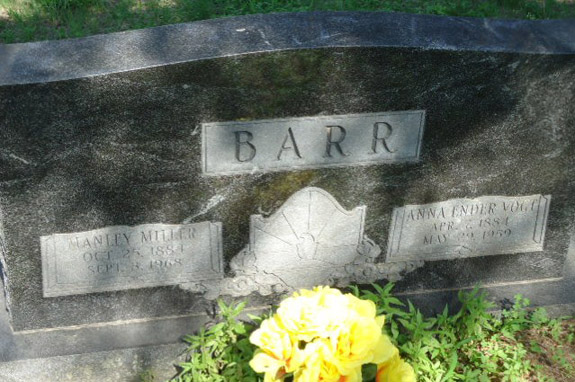
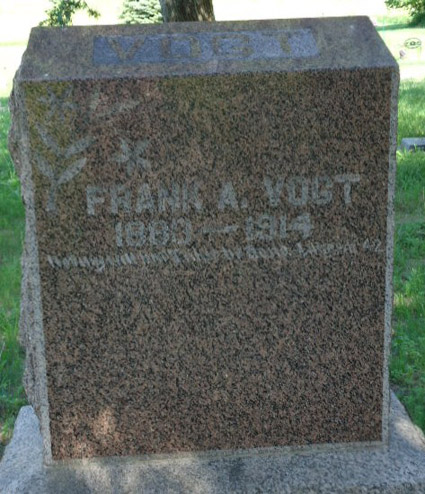

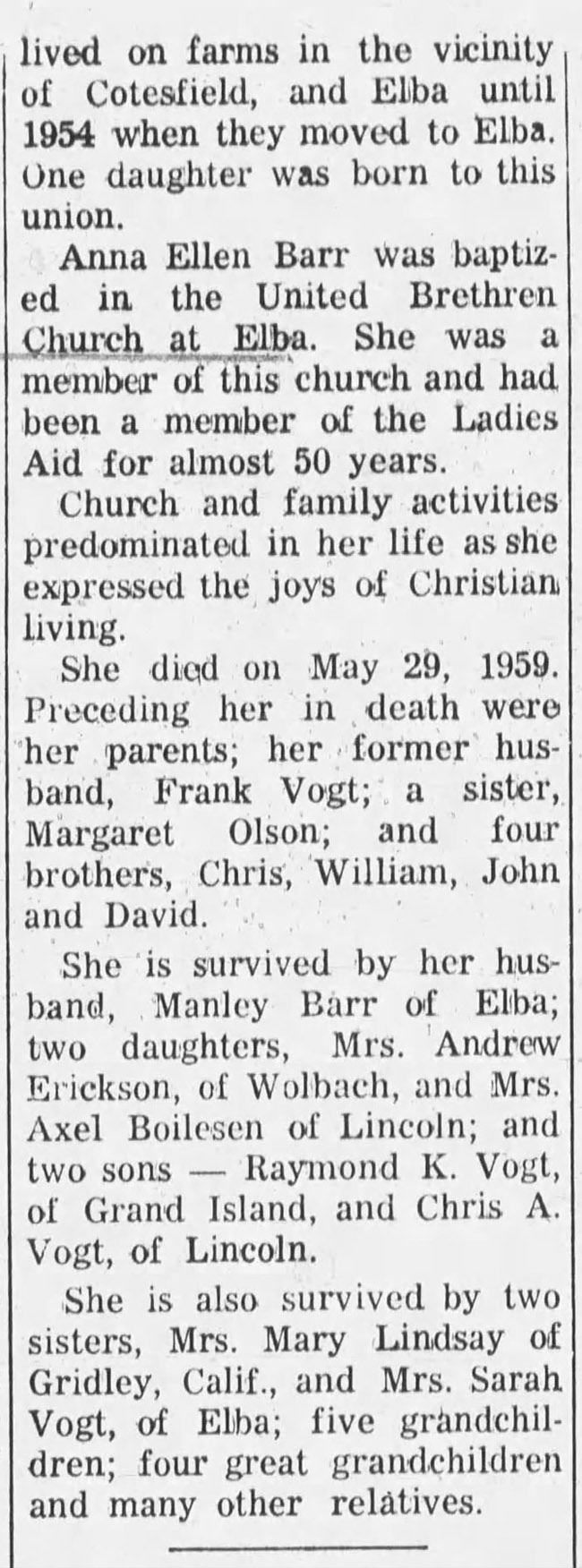
The Phonograph,
June 3, 1959
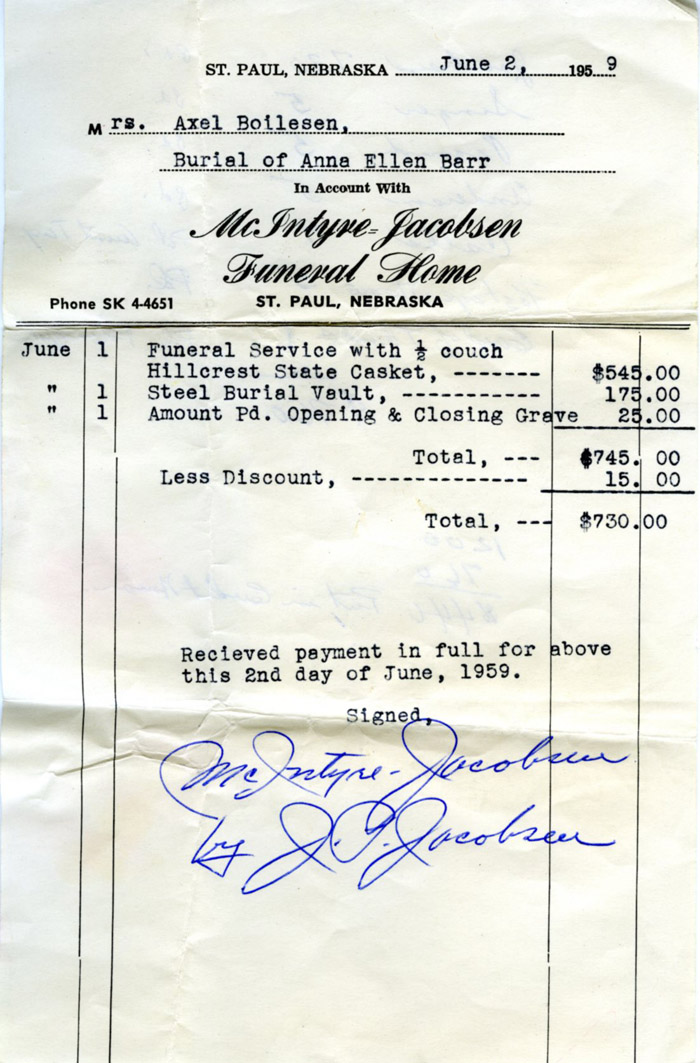
Frank Vogt Obituary,
The Phonograph, February 26, 1914,

Sarah ("Tae") Christina
Eve Vogt (born Ender) was born
on December 26, 1881, in Elba, Nebraska, to Christian Ender and
Bertha Ender (born Erickson).
Sarah married Ernest William Vogt.
Ernest was born on August 1 1879, in Nebraska. Ernest died on September
27, 1925. They had 3 children: Kenneth Vogt, Fern Adnelle Vogt Zavitka,
and Eudean Vogt Lehn. Sarah lived on her farm near Elba until 1943
when she moved into Elba.
Sarah Vogt passed on March 22, 1974.
Songs at her funeral were "Ivory Palaces" and "How
Great Thou Art." (Note that Anna Barr's funeral also included
"Ivory Palaces.")

The Phonograph Herald,
March 27, 1974
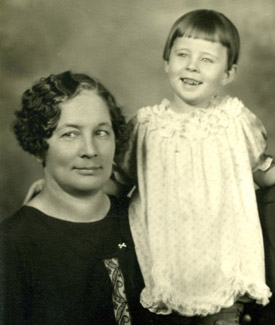
Other
Betty Stories Menu
|



